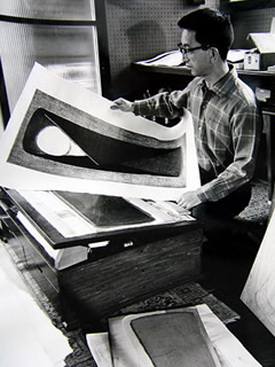Kaoru Kawano (1916-1965)
Kaoru Kawano, born in 1916 in Hokkaido, Japan, was a prominent figure in the sosaku hanga movement during the Showa period. Educated at the Kawabata Art School starting in 1934, Kawano initially pursued oil painting but later shifted his focus to woodblock printmaking. This transition marked his adoption of a modernist approach that emphasised personal creativity and individual technique in creating his artworks. Kawano's style is notably characterised by the use of bold, bright colours and stylised, simplified forms, integrating traditional Japanese subjects like geisha, kabuki actors, and landscapes with a contemporary twist. These elements gave his prints a distinctive graphic quality that differentiated them from the more detailed traditional prints of earlier periods.
Throughout his career, Kawano became known for his innovative use of wood grain to enhance textures, a technique that added a unique tactile element to his abstract depictions of children and simple shapes. His prints enjoyed popularity, especially abroad, becoming favoured gifts and collectibles in the United States and other countries, though they were less popular domestically due to the economic conditions in Japan at the time. Despite his international success and participation in exhibitions around the world, Kawano never traveled outside Japan due to health issues. He continued to produce and exhibit his work prolifically until his untimely death in 1965 at the age of 49. Today, Kaoru Kawano is remembered as a significant contributor to the sosaku hanga movement, with his prints still highly sought after by collectors globally.

Portrait of the artist Kaoru Kawano

Signature and seal of the artist Kaoru Kawano

